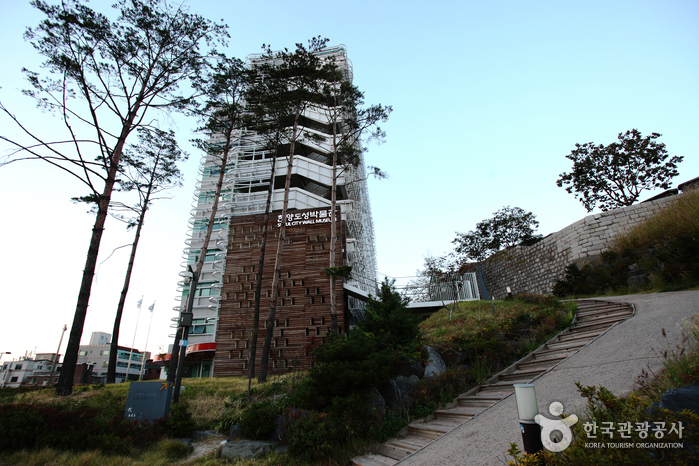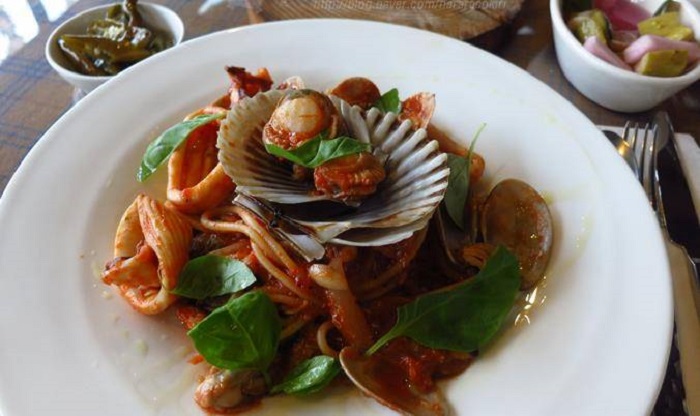Bon PALETE (봉파레트)
4.0Km 2021-03-29
57-1, Seongbuk-ro, Seongbuk-gu, Seoul
+82-2-766-0827
You can enjoy delicious meals at a hanok restaurant. This Western dishes restaurant is located in Seongbuk-gu, Seoul. The representative menu is seafood pasta.
Seoul City Wall Museum (한양도성박물관)
4.0Km 2023-12-22
283, Yulgok-ro, Jongno-gu, Seoul
+82-2-724-0243
Hanyangdoseong, the Seoul City Wall, built in 1396, was the city fortress wall that protected the capital city Seoul for over 600 years. The fortress wall was built along the terrains and although it became partially damaged during the modernization process, its original form remains well to this day, making it a cultural heritage that coexists with the modern city. The Seoul City Wall Museum, located in Heungjinjimun Park, is a museum containing the history and culture of city wall from the Joseon dynasty to the present. It is a cultural space with a permanent exhibition hall, special exhibition hall, city wall information center, and study room.
Sujeong Pharmacy [Tax Refund Shop] (수정약국)
4.0Km 2024-04-22
1F, 195, Jangchungdan-ro, Jung-gu, Seoul
-
bon PALETE(봉파레트)
4.0Km 2020-12-24
57-1 Seongbuk-ro Seongbuk-gu Seoul
+82-2-766-0827
You can enjoy delicious meals at a hanok restaurant. This Western dishes restaurant is located in Seongbuk-gu, Seoul. The representative menu is seafood pasta.
365 Pharmacy - Hongik Univ. Branch [Tax Refund Shop] (365약국 홍대)
4.0Km 2024-04-16
365 Pharmacy, 43, Wausan-ro 27-gil, Mapo-gu, Seoul
-
Motion - apM Branch [Tax Refund Shop] (모션 APM)
4.0Km 2024-04-23
4F, #155, to #157, 253, Jangchungdan-ro, Jung-gu, Seoul
-
Olens - Dongdaemun Branch [Tax Refund Shop] (오렌즈 동대문)
4.0Km 2024-04-16
1F, 251, Jangchungdan-ro, Jung-gu, Seoul
-
Olive Young - Dongdaemun History & Culture Park Branch [Tax Refund Shop] (올리브영 동대문역사문화공원역)
4.0Km 2024-04-18
251, Jangchungdan-ro, Jung-gu, Seoul
-
Jangchungdan Park (장충단공원)
4.0Km 2020-03-18
261, Dongho-ro, Jung-gu, Seoul
Jangchungdan Park is located on the northeastern foot of Namsan Mountain. On August 20th, 1895, Empress Myeongseong was killed by Japanese soldiers in Gyeongbokgung Palace and many Korean soldiers such as Yi Gyeong-jik and Hong Gye-hun died while trying to hold back the intruders. In memory of these soldiers, Emperor Gojong built the Jangchungdan Shrine in November 1900 at the current site of the Shilla Hotel guesthouse. The shrine was lost during the Korean War and the area was renovated into a park in 1919.
On September 22, 1984, Jangchungdan Park was designated the 374th neighborhood park of Korea and part of the park was merged with Namsan Park. The remaining area retained the name “Jangchungdan Park” and is still home to cultural assets such as the Jangchungdan Memorial Stone, Supyogyo, Seungjeongjeon, Gwanseongmyo, and Waryongmyo. The park is considered a landmark of patriotism since it contains the 1919 Independence Movement of Korea Memorial Stone and other monuments dedicated to people such as Han Yong-un, Yu Gwan-sun, and Gim Yong-hwan who fought for the independence of Korea.

![Sujeong Pharmacy [Tax Refund Shop] (수정약국)](http://tong.visitkorea.or.kr/cms/resource/57/2878757_image2_1.jpg)

![Hongik Pharmacy [Tax Refund Shop] (홍익약국)](http://tong.visitkorea.or.kr/cms/resource/48/3312848_image2_1.jpg)
![365 Pharmacy - Hongik Univ. Branch [Tax Refund Shop] (365약국 홍대)](http://tong.visitkorea.or.kr/cms/resource/01/2888601_image2_1.jpg)
![Motion - apM Branch [Tax Refund Shop] (모션 APM)](http://tong.visitkorea.or.kr/cms/resource/52/2889352_image2_1.jpg)
![Olens - Dongdaemun Branch [Tax Refund Shop] (오렌즈 동대문)](http://tong.visitkorea.or.kr/cms/resource/81/2887981_image2_1.jpg)
![Olive Young - Dongdaemun History & Culture Park Branch [Tax Refund Shop] (올리브영 동대문역사문화공원역)](http://tong.visitkorea.or.kr/cms/resource/10/2889310_image2_1.jpg)

 English
English
 한국어
한국어 日本語
日本語 中文(简体)
中文(简体) Deutsch
Deutsch Français
Français Español
Español Русский
Русский